← Back to Module 16
ITS ePrimer Presentation
Module 16: ITS Emerging Opportunities and Challenges
Slide 1:

ITS ePrimer
Module 16: ITS Emerging Opportunities and Challenges
ITS Professional Capacity Building Program
ITS Joint Program Office
U.S. Department of Transportation

Author’s Slide 1 meeting notes below:
This module is sponsored by the U.S. Department of Transportation’s ITS Professional Capacity Building (PCB) Program. The ITS PCB Program is part of the Research and Innovative Technology Administration’s ITS Joint Program Office. Thank you for participating and we hope you find this module helpful.
Slide 2:
Instructor

Eva Lerner-Lam
Founder and President Palisades Consulting Group, Inc.
Author’s Slide 2 meeting notes below:
- Founder and President of Palisades Consulting Group, Inc.
- Eva specializes in the application of technologies in urban and regional transportation systems
- Active member of ITE and has served in various appointed positions since early 1980’s, including the ITE International Board of Direction (China Representative)
- Winner of several ITE Awards, including the 1995 ITE Engineer of the Year Award and the 1991 Best Paper Award, Institute of Transportation Engineers, 61st Annual Meeting
- Bachelor’s degree in Economics from Princeton University; Master’s in Civil Engineering/Transportation Systems from MIT
Slide 3:
Learning Objectives
- Understand how rapid developments in data, computing, and telecommunications are changing fundamental assumptions in transportation demand, supply, and operational management
- Define ITS use cases for 4IR technologies so transportation professionals can better plan, design, engineer, and implement intelligent transportation systems (ITS) programs and projects.
Author’s Slide 3 meeting notes below:
Two primary learning objectives:
- Understand how rapid developments in data, computing, and telecommunications are changing fundamental assumptions in transportation demand, supply, and operational management. Together, they are offering more efficient and effective ways to build and operate transportation systems.
- Define ITS use cases for 4th Industrial Revolution technologies so transportation professionals can better plan, design, engineer, and implement intelligent transportation systems (ITS) programs and projects.
Slide 4:
INTRODUCTION
This module describes key “Fourth Industrial Revolution” (4IR) technologies that are presenting new opportunities and challenges for the transportation professional.
Author’s Slide 4 meeting notes below:
With the Nation’s aggressive new efforts at the start of the second decade of the 21st century to fix and rebuild its infrastructure, transportation professionals have a truly unique opportunity to leverage 4IR technologies to innovate smarter, more resilient, sustainable transportation systems for the future.
Slide 5:
ITS is the intersection of two domains…

ITS is at the Intersection of Key Transportation Stakeholders and Fourth Industrial Revolution Technologies
Author’s Slide 5 meeting notes below:
ITS is at the Intersection of Key Transportation Stakeholders and Fourth Industrial Revolution Technologies. Not all Travelers, Vehicles and Infrastructure will need 4IR Technologies, and not all 4IR Technologies have Travelers-Vehicles-Infrastructure uses. It’s really just the INTERSECTION of the two realms that creates Intelligent Transportation Systems
Slide 6:
KEY TRANSPORTATION STAKEHOLDERS

Author’s Slide 6 meeting notes below:
TRAVELERS, VEHICLES, AND INFRASTRUCTURE: Each has its own set of 4IR opportunities and challenges.
Slide 7:
Travelers & ITS
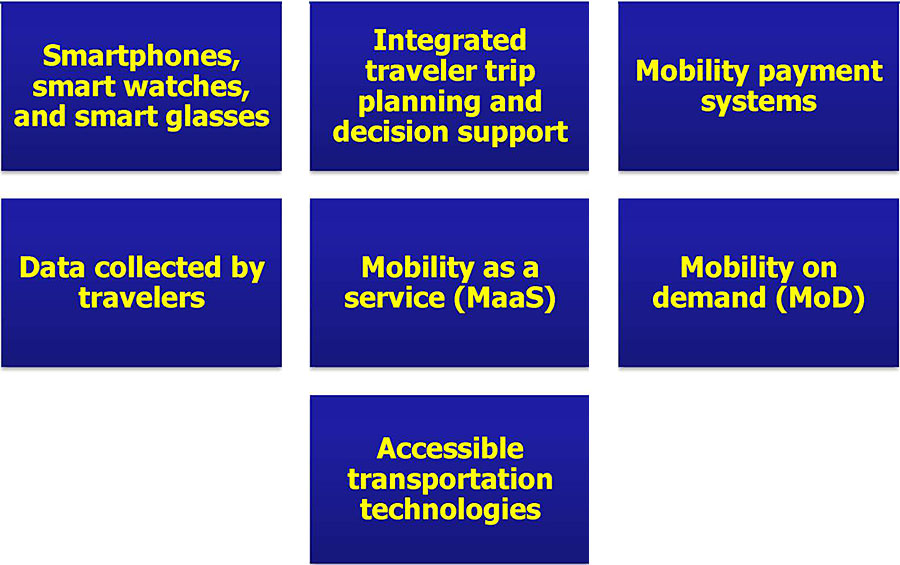
Author’s Slide 7 meeting notes below:
Smartphones, smart watches, and smart glasses will continue to connect the owners of such devices as nodes on the Internet of Things (IoT).
Integrated traveler trip planning and decision support will use artificial intelligence-based traffic and toll pricing prediction to plan multimodal navigation routes.
Mobility payment systems will gain momentum as app-based payment systems enable a societal trend toward a cashless economy.
Data collected by travelers will in and of itself become an asset for monetization by device manufacturers, app developers, and web service providers.
Mobility as a service (MaaS) will provide gateways to ride hailing, ridesharing, carsharing, bike sharing, and e-scooters as well as traditional transportation services such as public transit and taxis using 4IR data, computing, and telecommunications innovations.
Mobility on demand (MoD) will continue to evolve as integrated and multimodal transportation operators seek to interact and/or influence the supply and demand sides of transportation systems using 4IR data, computing, and telecommunications innovations.
Accessible transportation technologies will enable wayfinding and navigation, pre-trip concierge and virtualization, safe intersection crossing, robotics, and automation functions to provide safe and reliable ITS innovations for people needing assistance with their transportation needs.
Slide 8:
Vehicles & ITS
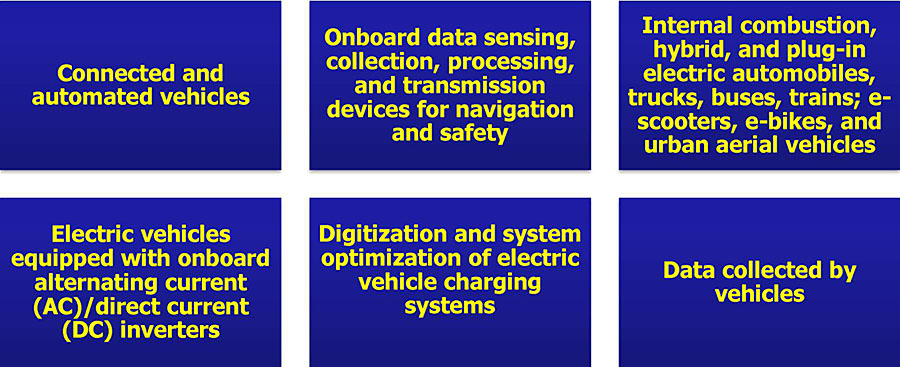
Author’s Slide 8 meeting notes below:
Connected and automated vehicles will rely heavily on 4IR technologies in order to operate in connected and automated ways.
Onboard data sensing, collection, processing, and transmission devices for navigation and safety will improve vehicle operations while simultaneously serving as probes to monitor traffic and provide data and information for other ITS stakeholders.
Internal combustion, hybrid, and plug-in electric automobiles, trucks, buses, trains; e-scooters, e-bikes, and urban aerial vehicles will all rely heavily on 4IR technologies for energy consumption monitoring and infrastructure capital investment.
Electric vehicles equipped with onboard alternating current (AC)/direct current (DC) inverters will become mobile energy storage units that can deliver energy back into the electric grid on demand.
Digitization and system optimization of electric vehicle charging systems will help power generators and distributors manage electric grids with more robust analysis and control.
Data collected by vehicles will become an asset for monetization by public agencies and private enterprises.
Slide 9:
Infrastructure & ITS
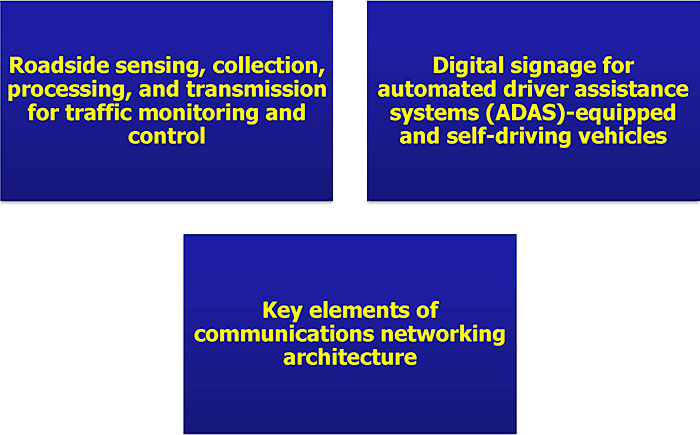
Author’s Slide 9 meeting notes below:
Roadside sensing, collection, processing, and transmission for traffic monitoring and control will become natural sites for edge computing of traffic and transportation management.
Digital signage for automated driver assistance systems (ADAS)-equipped and self-driving vehicles will evolve with a strong assist from a long-awaited update of Manual of Traffic Control Devices, including a new section, Part 5 Automated Vehicles.
Key elements of communications networking architecture will undergo enormous evolutionary changes as the sheer quantity of data will multiply to take up ever-increasing quantities of bandwidth in physically-limited frequency spectra.
Slide 10:
Infrastructure & ITS, cont’d.
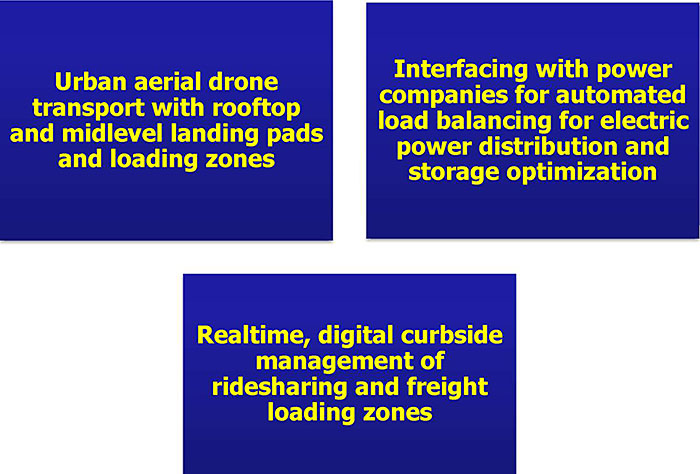
Author’s Slide 10 meeting notes below:
Urban aerial drone transport with rooftop and midlevel landing pads and loading zones will reduce ground-level transportation congestion but will also create noise and wind buffering and traffic channelization challenges.
Interfacing with power companies for automated load balancing for electric power distribution and storage optimization will be critical but the appropriate policymaking bodies have yet to be convened.
Realtime, digital curbside management of ridesharing and freight loading zones will reduce urban street congestion.
Slide 11:
Key 4IR Technologies Suitable for ITS
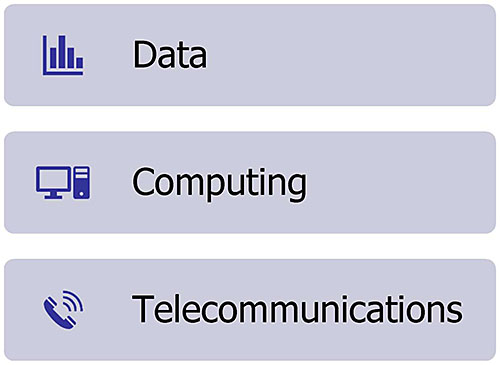
Author’s Slide 11 meeting notes below:
There are three basic components to 4th Industrial Revolution Technologies that have a direct bearing on Intelligent Transportation Systems: DATA, COMPUTING, AND TELECOMMUNICATIONS.
Slide 12:

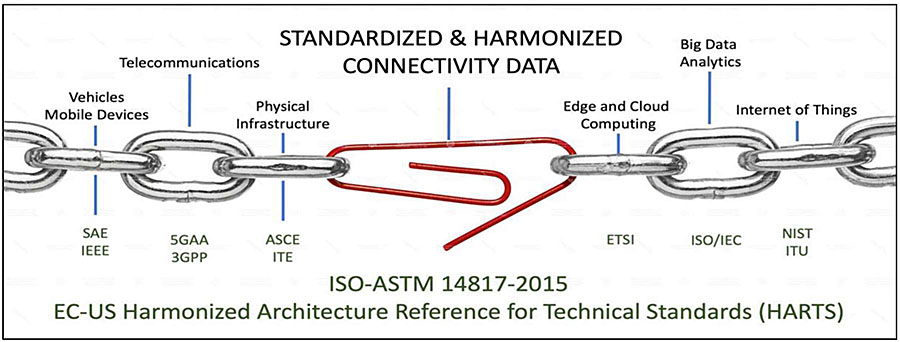
Author’s Slide 12 meeting notes below:
The advent of 4IR technologies greatly enhances the potential of ITS for its stakeholders because they enable travelers, vehicles, and control centers to generate, exchange, and process data.
However, as the devices and infrastructures evolve to higher levels of technological sophistication, the underlying data definitions and application programming interface standards (APIs) become ever more critical to the optimal functioning of the technologies.
True connectivity depends on standardized and harmonized data. When it comes to “the weakest link” in ITS, this is it.
Slide 13:

Challenges
- A lot of data to collect, process, analyze, store, and use
- Ensuring common definitions of ITS data and use cases
- Managing cybersecurity risks
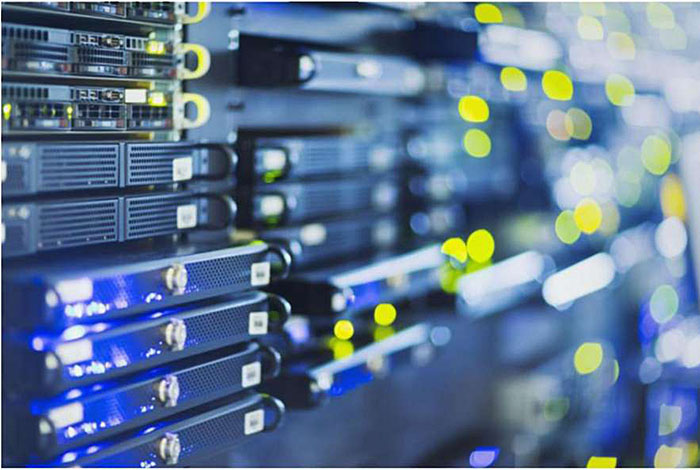
Opportunities
- Updating the Manual of Uniform Traffic Control Devices
- Optimizing speed and accuracy of ITS data collection
- Collaborative partnerships in data access
- Common data architecture, storage, and sharing
- Development of U.S. DOT Security Architecture
Author’s Slide 13 meeting notes below:
DATA CHALLENGES:
- Data, data, data…lots of it, often too much of it! It has to be collected, processed, analyzed, stored, and intelligently used.
- Data collected by different proprietary devices and systems often have unique definitions and are not usable by other devices and systems. (Think of how currencies work. Each nation has its own currency. If you want to buy something in another country, you need to EXCHANGE your currency for that country’s currency. Both buyer and seller need a mutually acceptable EXCHANGE RATE.
- Hacking of data that is collected by ITS devices can introduce safety and security risks across ITS devices and interfaces.
DATA OPPORTUNITIES:
- Good news: MUTCD is being updated! (Last update was 2009).
- Computing and telecommunications are enhancing and optimizing the speed and accuracy of ITS data collection, processing, analysis, storage, and use
- There are increasing numbers of collaborative partnerships across the country that are making it possible to share data.
- U.S. DOT is developing a Security Architecture that addresses some of the key types of cybersecurity risks.
Slide 14:

Challenges
- Handling Big Data
- Cloud and edge computing architectures
- Cybersecurity risks
- Latency effects

Opportunities
- Increased CPU processing speeds
- Common IoT protocols and addressing schemes
- Efficient handling of big data with new advances in computation and data storage methods
- Emergence of Machine Learning Technologies
- Augmented Reality
- Virtual Reality
- AI Technologies
Author’s Slide 14 meeting notes below:
COMPUTING CHALLENGES
- Mostly due to the enormous amounts of data (“Big Data”) collected by sensors throughout a transportation system Cloud and edge computing architectures can help but haven’t yet been thoroughly worked out.
- Hacking of computing systems can lead to cybersecurity risks.
- Minimizing latency is essential to certain types of ITS computing, e.g., calculating distance-to-impact for two moving vehicles headed toward each other at an intersection.
COMPUTING OPPORTUNITIES
- Faster computer processing chips can reduce latency.
- Internet of Things protocols and addressing schemes are being rapidly developed.
- New advances in computing and data storage methods are improving the efficiency of big data handling.
- New machine learning technologies such as Augmented Reality, Virtual Reality, and Artificial Intelligence technologies are improving the efficiency of CPUs.
Slide 15:

Challenges
- DSRC and C-V2X policy uncertainties related to frequency spectrum allocations
- Cost and health risk uncertainties of building new 5G networks and base stations
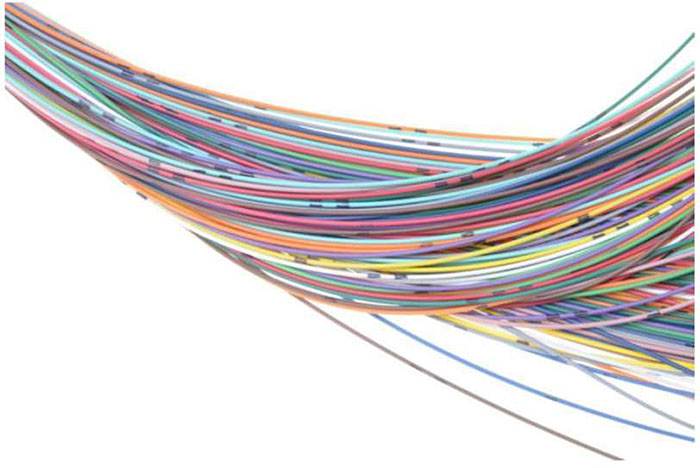
Opportunities
- Evolution of 5G mobile networks
- Integration of 5G networks and communication systems for use by first responders
Author’s Slide 15 meeting notes below:
TELCO CHALLENGES
- Uncertainties related to frequency spectrum allocations (battle between Dedicated Short-Range Communications and Cellular Vehicle-to-X).
- The health risks of 5G technology are not well-studied. Because they are based on “beam-forming” and are, by definition, “short-range,” they are physically much closer to people than prior generations of telecommunications, and more base station units and installations are required than for prior generations.
TELCO OPPORTUNITIES
- The sheer momentum of 5G mobile network expansion is indisputable.
- First responders will be the first to rely on 5G for emergency communications, and their 5G capabilities will evolve quickly to enhance their intelligent transportation operations.
Slide 16:
General Challenges and Opportunities
Challenges
- Despite rapid developments in 4IR, successful adoption in ITS use cases depends on multiple, collaborative interactions among multiple disciplines and entities
- Many obstacles to standardizing data and application programming interfaces
- Interoperability / integration with existing (legacy) communication systems
- Deteriorating infrastructure and lack of stable sources of funding
- National security threats from collection of data by ITS devices
Opportunities
- Multidisciplinary understanding
- Strengthen the weak links
- New legislation for infrastructure projects
- Follow the money
- Help make the use of available funding count

Author’s Slide 16 meeting notes below:
“Challenges and Opportunities” = “Yin and Yang” = “two sides of the same coin”
- Interoperability, integration, standards, investments in infrastructure, protecting against national security threats are key to successful ITS deployments
“Follow the money”
Important for transportation professionals to help make the use of that money count. Many 4IR companies and investors are technology-oriented and not domain experts in ITS; the new techs attract large investments, so it’s important for transportation professionals to get a seat at that table and add your experience and voice to the conversation.
Slide 17:
Summary
ITS professionals must:
- Stay up-to-date with progress in 4IR technologies
- Be willing to engage in public-private partnerships to help leverage the private sector’s 4IR technology investments and society’s best interests in applying those investments in ITS
- Ramp up efforts to protect against privacy and cybersecurity risks (domestic and foreign)
- Monitor and plan for post-COVID-19 pandemic shifts in urban density and traffic patterns
- Invest in capacity building (training and education) in both the domain elements of transportation (Travelers, Vehicles, and Infrastructure) and the 4IR technologies that directly affect how they operate together (Data, Computing, and Telecommunications) in order to truly achieve “intelligent” transportation systems.
Author’s Slide 17 meeting notes below:
ITS professionals must:
- Stay up-to-date with progress in 4IR technologies
- Be willing to engage in public-private partnerships to help leverage the private sector’s 4IR technology investments and society’s best interests in applying those investments in ITS
- Ramp up efforts to protect against privacy and cybersecurity risks (domestic and foreign)
- Monitor and plan for post-COVID-19 pandemic shifts in urban density and traffic patterns
- Invest in capacity building (training and education) in both the domain elements of transportation (Travelers, Vehicles, and Infrastructure) and the 4IR technologies that directly affect how they operate together (Data, Computing, and Telecommunications) in order to truly achieve “intelligent” transportation systems.
Slide 18:
Key References
Module 16 contains more than 75 references, mostly related to standards and how they can help to integrate “Travelers, Vehicles and Infrastructure” with “4th Industrial Revolution Technologies.”
Of particular note:
- The Manual on Uniform Traffic Control Devices for Streets and Highways (MUTCD)(2021)
- National Transportation Communications for Intelligent Transportation System (ITS) Protocol (NTCIP)
- ISO 14817-2:2015 ITS central data dictionaries
- 5G Automotive Association (5GAA)
- “Adoption of Transit Communications Interface Profiles in the Transit Industry,” Intelligent Transportation Society of America (2016)
Author’s Slide 18 meeting notes below:
Module 16 contains more than 75 references, mostly related to standards and how they can help to integrate “Travelers, Vehicles and Infrastructure” with “4th Industrial Revolution Technologies.”
Of particular note:
- The Manual on Uniform Traffic Control Devices for Streets and Highways (MUTCD) (2021)
- National Transportation Communications for Intelligent Transportation System (ITS) Protocol (NTCIP)
- ISO 14817-2:2015 ITS central data dictionaries
- 5G Automotive Association (5GAA)
- “Adoption of Transit Communications Interface Profiles in the Transit Industry,” Intelligent Transportation Society of America (2016)
Slide 19:
Questions?
Eva Lerner-Lam, elernerlam@palisadesgroup.com
Return to top ↑